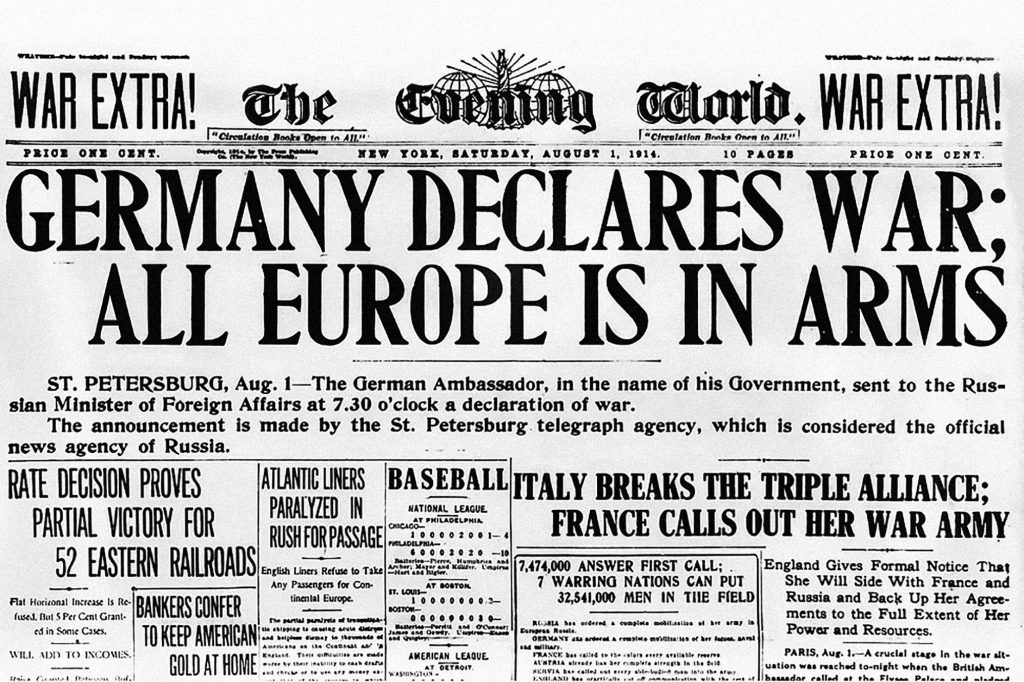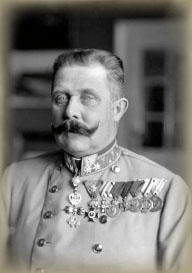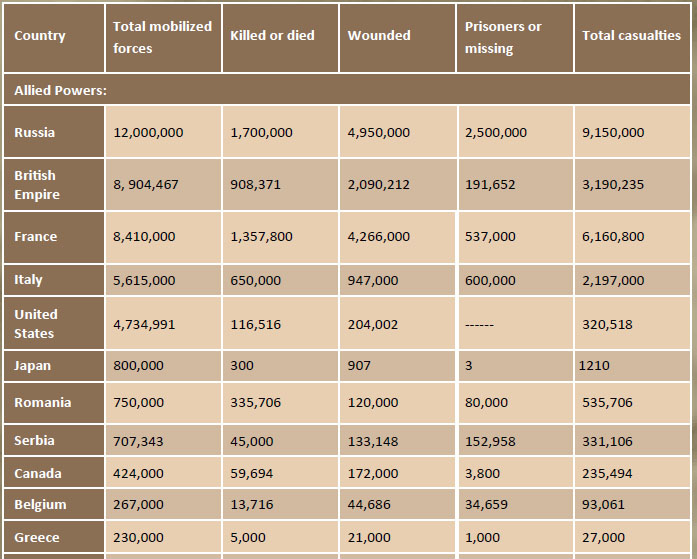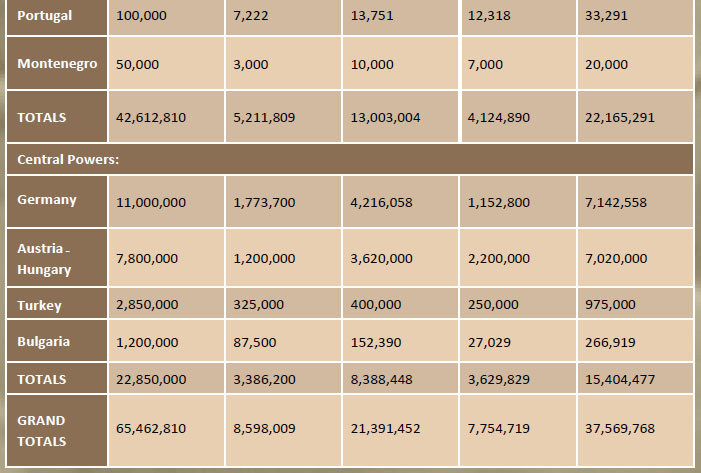WORLD WAR I
World War I occurred between 28 July 1914 and 11 November 1918. By the end of the war, 20 million people had been killed. Imperialism, militarism, nationalism and Mutual Defence Alliances were the main factors which led to war. Mutual Defence Alliances were formed between Russia and Serbia, Germany and Austria Hungary, Britain, France and Belgium, Japan and Britain. The assassination of Archduke Franz Ferdinand of Austria-Hungary has acted as the catalyst for World War I.


On 28 June 1914, Gavrilo Princip, a 19-year old Bosnian Serb nationalist, assassinated the Austro-Hungarian heir Archduke Franz Ferdinand and his wife in Sarajevo. In response, on 28 July, Austria-Hungary issued an ultimatum to Serbia which was designed to lead to war in order to secure Austro-Hungarian and German interests in the region. No State in the world would have agreed to the full terms of the ultimatum issued to Serbia and as such, a regional war was almost guaranteed. Thus, it resulted in the July Crisis: a network of interlocking alliances; and both diplomatic and military miscalculations which enlarged the crisis from a bilateral issue in the Balkans to one involving most of Europe and the world.
On 24 July, Russian ministers agreed on a partial mobilisation to aid Serbia – if necessary – while Serbia mobilised on 25 July, the same day on which Serbian Prime Minister, Nicola Pasic, delivered his response to the Austro-Hungarian embassy in Belgrade accepting all terms of the ultimatum with one exception: the refusal of Austro-Hungarian participation in an inquiry into the assassination of the archduke. With this, the Austro-Hungarian ambassador to Serbia, Baron Gieslingen, broke Habsburg dual monarchy diplomatic relations with Serbia and fled the country. On 28 July, Austria-Hungary declared war on Serbia. On 30 July, Tsar Nicolas II, authorised full Russian mobilisation to support Serbia; and on 1 August, Germany declared war on Russia while France began general mobilisation to support Russia. On 2 August, Germany carried out part of its Schlieffen Plan — name given to Germany’s war plans on account of Field Marshal Alfred von Schlieffen — to invade France following Russian mobilization; Germany invaded Luxembourg followed by issuing an ultimatum for free passage through neutral Belgium: an essential element in achieving a quick victory over France. When this was refused, German forces invaded Belgium on 4 August, having declared war on France the previous day. The Belgian government invoked the 1839 Treaty of London and in compliance with its obligations under this, Britain declared war on Germany on 4 August. On 5 August, Austria-Hungary declared war on Russia and on 12 August, Britain and France declared war on Austria-Hungary; on the 23rd, Japan sided with the Entente, seizing German possessions in China and the Pacific. The Entente and its allies would eventually become known as the Allied Powers, while the grouping of Austria-Hungary, Germany and their allies would become known as the Central Powers. The Schlieffen Plan was the strategy for the German invasion of France and Belgium in August 1914. Field Marshal Alfred von Schlieffen was the Chief of the Imperial Army German General Staff from 1891 to 1906 and in 1905- 06 devised a deployment plan for a winning offensive in a one-front war against the French Third Republic. After the war, German historians and other writers described the plan as a blueprint for victory. The United States initially remained neutral, but the sinking of the Lusitania in May 1915, the subsequent sinking of American merchant ships by German U-Boat submarines and the Zimmerman telegram being intercepted — revealing a German plot to help Mexico reclaim territory lost during the Mexican- American War— all contributed to the U.S. declaring war on Germany on 6 April 1917. From March 1918, Germany launched the Ludendorff Offensive or German Spring.
Offensive consisting of four main attacks along the Western Front, in a bid to end the war with a victory for the Central Powers. The plan was to advance swiftly through the Allied lines before full U.S. support arrived to bolster the Allies. The German Army saw great success and advanced further than either side had, since 1914.
However, the German’s advance was short-lived due to high numbers of casualties and problems to supply troops with food, fuel and ammunition.
In July 1918, U.S. reinforcements arrived; the Allies rallied and drove the Germans back as per the Hundred Days Offensive: a counter-offensive which resulted in Germany losing ground during the Spring Offensive and the fall of the Hindenburg Line. On 29 September 1918, Bulgaria became the first nation of the Central Powers to sign an armistice or The Armistice of Salonica following a successful Allied offensive on the Macedonian Front. This was followed by negotiations with the Ottoman Empire and conclusion of The Armistice of Mudros on 30 October, which took effect on 31 October, officially ending hostilities between the Allies and Ottoman Empire. The dissolution of the Habsburg dual monarchy of Austria-Hungary, in October, culminated with the armistice between the Allies and Austria-Hungary, signed on 3 November. With its allies defeated, its people hungry due to Allied blockade on supplies, its navy in tatters due to mutiny and widespread revolution calling for a republic gaining rapid momentum, German prince and Chancellor of the German Empire, Prince Max von Baden then stepped aside as Chancellor, and Social Democrat, Friedrich Ebert, took over and immediately formed a provisional government. An armistice between the Allies and Germany was signed in a railway carriage at Rethondes, Compeigne, France on 11 November 1918, ending hostilities on the Western Front and effectively, the war. Kaiser Wilhelm II officially abdicated on 28 November.
The Assassination of Archduke Franz Ferdinand
Archduke Franz Ferdinand of Austria and his wife Sophie were shot to death by a Bosnian Serb nationalist during an official visit to the Bosnian capital of Sarajevo on June 28, 1914. The archduke travelled to Sarajevo in June 1914 to inspect the Imperial armed forces in Bosnia and Herzegovina, annexed by Austria – Hungary in 1908. The annexation had angered Serbian nationalists, who believed the territories should be part of Serbia. A group of young nationalists hatched a plot to kill the archduke during his visit to Sarajevo, and after some missteps, 19 year old Gavrilo Princip was able to shoot the royal couple at point – blank range.


Chronology of the First World War
Casualties in WWI
The chart provides estimates of the number of soldiers killed, wounded, and reported missing during World War I. Exact numbers are often disputed and are nearly impossible to determine for a variety of reasons. Different countries used different methods to count their dead and injured, and some methods were more reliable than others. Records of some countries were destroyed during the war and its aftermath.




It is thought that doctor John McCrae (30 November 1872 – 28 January 1918) began the draft for his famous poem “In Flanders Fields” on the evening of the 2 May, 1915 in the second week of fighting during the Second Battle of Ypres. John McCrae was serving as a Major and a military doctor and was second in command of the 1st Brigade Canadian Field Artillery. The field guns of his brigade’s batteries were in position on the west bank of the Ypres-Yser canal, about two kilometres north of Ypres. The brigade had arrived there in the early hours of 23 April 1915.
It is believed that the death of his friend, Alexis Helmer, was the inspiration for McCrae’s poem “In Flanders Fields”. The exact details of when the first draft was written may never be known because there are various accounts by those who were with McCrae at that time.
